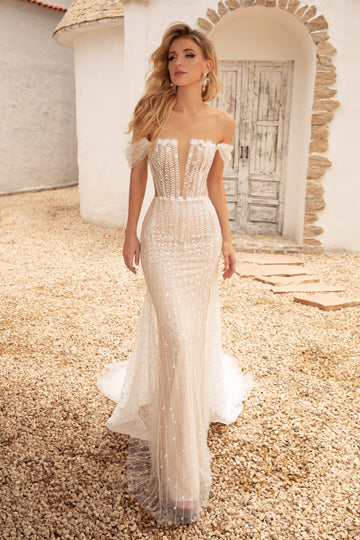The Journey of Bridal Silhouette Changes: A Historical Perspective
The Journey of Bridal Silhouette Changes: A Historical Perspective
Understanding Bridal Silhouette Evolution
Throughout history, bridal fashion has undergone a remarkable transformation, reflecting societal changes, cultural influences, and artistic movements. The journey of bridal silhouette changes is not just a narrative of style; it encapsulates the essence of love, tradition, and the evolution of women's roles in society.
Historical Overview of Bridal Silhouettes
The concept of a bride's attire varies immensely across cultures and epochs. From the ornate gowns of the Victorian era to the sleek designs of modern weddings, each silhouette tells a different story.
Victorian Era: The Hourglass Figure
During the Victorian period (1837-1901), bridal gowns typically featured an hourglass silhouette, characterized by a fitted bodice and voluminous skirts supported by crinolines. This style emphasized femininity and was influenced by the social norms of the time, where women were often viewed through the lens of domesticity and virtue.
1920s: The Flapper Influence
The 1920s brought about a revolutionary change in women's fashion with the flapper movement. Bridal silhouettes reflected this cultural shift towards more liberated femininity, featuring straight lines, lower hemlines, and dropped waistlines.
The 1920s designs embodied a sense of freedom, moving away from restrictive corsetry.
Mid-Century: The New Look
In the 1950s, Christian Dior introduced the "New Look," which rejuvenated bridal fashion. This silhouette emphasized a cinched waist and full skirt, reminiscent of the post-war desire for elegance and luxury. Brides donned gowns that highlighted their figures while incorporating rich fabrics and intricate detailing.
Contemporary Trends: Personalization and Diversity
The late 20th and early 21st centuries saw an explosion of diversity in bridal fashion, with silhouettes tailored to the individual bride’s style. Designers now prioritize personal expression over tradition, offering various shapes like A-line, mermaid, and ball gown. As well, cultural influences have enriched the bridal landscape, leading to increased representation across different cultures and body types. This shift signifies a broader acceptance of varied aesthetics, moving beyond the conventional white gown.
A Closer Look at Popular Silhouettes
| Silhouette Type | Description | Ideal Body Type |
| A-Line | Fitted at the top and gradually flares out from the waist, resembling the shape of an 'A.' | Most body types; particularly flattering for pear-shaped figures. |
| Mermaid | Tight-fitting through the body and flares out at or below the knee, emphasizing curves. | Hourglass and athletic body types. |
| Ball Gown | Features a fitted bodice and full skirt, perfect for a fairytale wedding. | All body types but especially suiting those looking for a classic look. |
| Empire Waist | The waistline sits just below the bust, flowing into a skirt, ideal for a flowing look. | Great for petites and brides looking for comfort. |
Influential Factors in Bridal Silhouette Changes
The evolution of bridal silhouettes is influenced by numerous factors, including:
Cultural Shifts
As society evolves, so do its values and aesthetics. The portrayal of women in media, changes in gender roles, and increasing acceptance of same-sex marriage have led to more inclusive and varied bridal fashion.
Fashion Trends
Styles in the broader fashion industry heavily impact bridal wear. Designers often draw inspiration from runway trends, leading to innovative designs that merge contemporary style with traditional elements.
Technological Advancements
Advancements in fabric technology and sewing techniques allow for unique silhouettes that were once impossible to create. This has led to the exploration of unconventional materials and designs, pushing the boundaries of bridal fashion.

The Global Influence on Bridal Fashion
In today’s globalized world, bridal fashion is no longer confined by geography. Influences from various cultures can be seen in contemporary designs, leading to a rich tapestry of styles. For instance, traditional Indian bridal attire often features bold colors and intricate embroidery, offering a stark contrast to Western white gowns.
Regional Popularity of Styles
In South Asia, brides often favor heavy lehengas, embellished with sequins and gold thread, celebrating cultural heritage. In contrast, Western brides are more inclined towards minimalist designs with an emphasis on clean lines. This cross-pollination of styles enriches the wedding landscape and offers brides worldwide more options to choose from.
The Future of Bridal Silhouette Changes
As we look towards the future, it’s evident that bridal fashion will continue to evolve. With the rising importance of sustainability, eco-conscious materials will likely become more prevalent. Moreover, the trend towards customization and individuality signifies a shift away from traditional norms towards more personalized expressions of love and commitment.
Conclusion: Navigating the Journey of Bridal Silhouette Changes
Understanding the journey of bridal silhouette changes offers a fascinating insight into cultural evolution, individual expression, and the craftsmanship behind wedding attire. As a bride planning for the big day, consider the silhouettes that resonate with you. Remember, your wedding gown should reflect not just your personal style, but also your love story. While trends will continue to shift, the essence of what a bridal gown represents—love, beauty, and celebration—will remain timeless.
Recommendations: When choosing your bridal silhouette, consider aspects such as your body type, personal style, and cultural background. Don’t hesitate to experiment with unconventional styles that resonate with your identity. Ultimately, the best choice is one that makes you feel confident and beautiful on your special day.
In conclusion, the journey of bridal silhouette changes narrates a larger story of societal transformation and artistry. Embrace the evolution and choose a silhouette that best encapsulates your unique journey to love.
